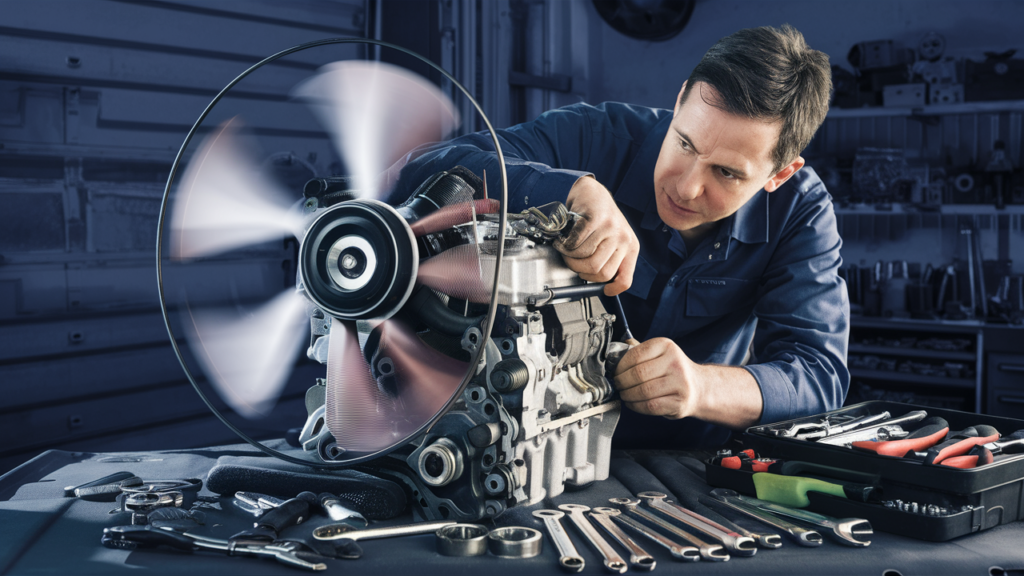
Troubleshooting Guide: Reasons Behind Continuous Running of Car Engine Fan
Here is a concise and accurate response to the query, based on the provided search results: The main reasons why a car’s radiator fan may run continuously, even when the engine is off, include:
Faulty temperature sensor or thermostat: A malfunctioning coolant temperature sensor or thermostat can send an incorrect signal to the engine control unit (ECU), causing the fan to run constantly.
Stuck or defective fan relay: A stuck or faulty cooling fan relay can continuously provide power to the fan, preventing it from turning off. Issues with the engine control module (ECU): Problems with the ECU, such as a software glitch or hardware failure, can disrupt the normal operation of the cooling fan.
Wiring or connector problems: Damaged wiring or loose/corroded connectors in the cooling fan circuit can cause the fan to malfunction and run continuously.
Mechanical issues: In the case of engine-driven fans, a stuck or faulty fan clutch can also lead to the fan running without stopping.
To diagnose and fix the issue, it is recommended to check the temperature sensor, fan relay, wiring, and ECU for any faults, and replace the affected components as necessary. A visual inspection of the fan and its components can also help identify any physical damage or wear.
In the intricate dance of components inside an automobile, the engine fan plays a crucial role in maintaining optimal operating temperatures. Picture this: while your car’s engine is hard at work powering your journey, the engine fan stands vigilant, ready to cool down the heated machinery lurking beneath the hood.
Yet, as many car owners have noticed with furrowed brows, sometimes this silent guardian seems to never take a break, persistently whirring away even after the ignition has been turned off. This unrelenting behavior can raise concerns and prompt questions about what lies beneath this continuous operation of the engine fan.

As we embark on a journey through the intricacies of automotive engineering, let us delve into the realms of troubleshooting guide dedicated to unraveling the mystery behind why your car’s engine fan refuses to rest.
While for some, the constant hum might go unnoticed amidst daily commutes, for others attuned to every sound their vehicle makes, this perpetual motion is akin to a persistent whisper hinting at underlying issues waiting to be uncovered. Join us as we dissect the reasons that keep your engine fan tirelessly spinning and unveil practical solutions to put those concerns to rest once and for all.
Engine Fan Basics.
The engine fan, also known as the radiator fan, plays a crucial role in a vehicle’s cooling system by assisting in regulating the operating temperature of the engine. Its primary function is to dissipate heat generated during the combustion process and avoid overheating.
As the engine operates, it produces a significant amount of heat that needs to be expelled to maintain optimal working conditions. The engine fan works in tandem with the radiator to ensure that excess heat is efficiently removed from the engine compartment.
In this cooling process, the engine fan helps by pulling cooler air through the radiator where it absorbs heat from the coolant circulating within, subsequently lowering its temperature before sending it back into the engine for further cooling cycles.
By maintaining suitable operating temperatures, the engine fan safeguards critical components from thermal damage and ensures smooth performance during various driving conditions.
Two main types of engine fans are prevalent in modern vehicles: mechanical fans powered by the engine itself via a belt or clutch system and electric fans controlled by sensors that trigger their operation based on temperature demands.
Mechanical fans are traditionally found in older car models and trucks where they rely on direct mechanical power transmission to spin at varying speeds according to engine requirements. Electric fans have become more common due to their efficiency in responding promptly to changing thermal needs without drawing excess power when not needed.
Understanding these fundamental aspects of the engine fan’s operation can assist car owners in troubleshooting issues related to continuous running and appreciating its significance within the vehicle’s overall cooling system architecture.
Common Causes for Continuous Engine Fan Operation.
Continuous operation of a car engine fan often stems from critical issues within the vehicle’s cooling system. One common cause is the activation of the fan as a safety measure in response to high temperatures under the hood.
When the engine reaches elevated temperatures, the fan engages to maintain optimal operating conditions and prevent overheating. This safety mechanism ensures that the engine stays within a safe temperature range, even if it results in prolonged fan activity.
A malfunctioning thermostat can also be a culprit behind the continuous running of the engine fan. The thermostat plays a crucial role in regulating coolant flow through the radiator based on the engine’s temperature.

If the thermostat fails or gets stuck in an open position, it can inaccurately signal to the fan that constant cooling is required, leading to ongoing engagement of the fan. Regular inspection and maintenance of the thermostat are essential to avoid such malfunctions.
Issues with coolant level or circulation can further contribute to persistent engine fan activity. Low coolant levels or restricted circulation due to blockages can disrupt the cooling process, forcing the fan to run continuously in an attempt to lower temperatures.
Checking coolant levels regularly and ensuring proper circulation by addressing any leaks or blockages are crucial steps in resolving this issue and preventing continuous operation of the engine fan, which could potentially lead to more severe problems if left unattended.
Electrical System Malfunctions.
When dealing with continuous engine fan operation, it’s crucial to inspect the electrical components of the cooling system. Faulty sensors or switches are common culprits behind misleading signals that prompt prolonged cooling cycles.
For instance, a malfunctioning coolant temperature sensor might inaccurately convey high temperatures to the engine control unit, triggering constant fan activation even when unnecessary. It is imperative to test these sensors for accuracy and replace them if they are found to be faulty.
Another critical electrical component to evaluate is the relay responsible for controlling the engine fan. A failing relay can disrupt the normal operation by keeping the fan running continuously, irrespective of the actual temperature conditions under the hood.
To address this issue, identifying and replacing a faulty relay should resolve the fan’s persistent activity. Regularly inspecting and testing relays as part of routine maintenance can prevent sudden malfunctions impacting the cooling system’s efficiency.
To troubleshoot potential electrical system malfunctions linked to continuous engine fan operation, start by conducting voltage tests on relevant sensors and switches. Utilize a multimeter to verify proper electrical signals being sent and received by these components.
If any discrepancies are detected, investigate further to pinpoint the root cause before proceeding with repairs or replacements. Additionally, ensure all connections are secure and free of corrosion or damage that could interfere with signal transmission within the cooling system’s electrical circuitry.
Coolant System Problems.
When it comes to the continuous operation of your car’s engine fan, issues within the coolant system can often be the culprit. One common problem stems from air pockets that may develop in the cooling system.
These air bubbles hinder the proper circulation of coolant through the engine, which disrupts the heat dissipation process and prompts the fan to run continuously in an attempt to cool down the overheating engine. Bleeding or purging these air pockets from the system is essential to restore optimal fluid flow and prevent unnecessary strain on the fan.
Moreover, leaks or blockages in hoses, connectors, or radiator components can also lead to persistent overheating concerns and trigger prolonged fan usage. A leak in the cooling system causes a loss of coolant, reducing its efficiency in dissipating heat from the engine.

On the other hand, blockages impede the smooth flow of coolant, resulting in localized heating that forces the engine fan to operate continuously to combat escalating temperatures. Regularly inspecting these components for any signs of damage or obstruction is crucial for maintaining a properly functioning cooling system.
To address coolant-related issues causing continual activation of your car’s engine fan, begin by visually examining all visible parts of the cooling system, like hoses and connections, for any leaks or abnormalities.
Next, check for any blockages within radiator channels or hoses that might impede fluid movement. If no visual cues are apparent, consider performing a pressure test on the cooling system to pinpoint hidden leaks that could be affecting overall performance.
By systematically troubleshooting and rectifying potential problems within your vehicle’s coolant system, you can ensure efficient cooling operations and prevent unnecessary stress on your engine fan during routine driving conditions.
Engine Overheating Scenarios.
When a vehicle’s engine faces genuine overheating issues, the continuous running of the engine fan becomes crucial to prevent potential damage. One common scenario where the engine fan operates perpetually is in stop-and-go traffic on scorching summer days.
In this situation, limited airflow through the radiator can lead to a spike in engine temperature, necessitating constant cooling from the fan. Drivers may notice steam emanating from under the hood or observe dashboard warnings highlighting rising temperatures as indicators that require immediate attention and action.
Upon encountering warning signs of overheating, drivers should take proactive measures to safeguard their vehicles and themselves. Pulling over safely to a designated spot away from traffic and turning off the engine allows for cooldown time and helps prevent further heat buildup.

Additionally, opening the hood carefully after ensuring it’s safe can facilitate quicker dissipation of heat. Drivers should avoid attempting to open the radiator cap when it’s hot to prevent burns from escaping steam or coolant splashes. For individuals comfortable with basic automotive knowledge, checking coolant levels once it’s safe can provide insights into potential causes of overheating.
Drivers facing an overheating scenario should refrain from continuing their journey until confirming that the engine has returned to a safe operating temperature. If uncertainty persists regarding necessary actions or if internal damage is suspected, seeking assistance from roadside services or professional mechanics can help diagnose underlying issues causing persistent engine fan activation.
By promptly addressing overheating concerns and understanding preventive measures, car owners can minimize risks of prolonged engine fan operation due to severe cooling system malfunctions that could escalate if left unattended.
Regular Maintenance Practices.
To avert the persistent whirring of your car’s engine fan, vigilance in adhering to scheduled maintenance is paramount. Much like ensuring your vehicle’s oil is changed routinely, checking vital components such as thermostats, sensors, and coolant levels can forestall unexpected glitches triggering continuous fan activity.
By incorporating these checks into your regular maintenance routine, you proactively safeguard your car against scenarios that necessitate incessant cooling.
Periodic inspections serve as preemptive strikes against potential malfunctions that might otherwise result in prolonged engine fan operation. Just as a doctor conducts routine check-ups to catch health issues early, monitoring critical elements within your car’s cooling system can circumvent unforeseen breakdowns.
This proactive approach not only elongates the lifespan of your vehicle but also minimizes the likelihood of being caught off guard by sudden mechanical failures.
Underlining the significance of preventive measures affirms that car owners are not merely reactive but actively engaged in preserving their vehicles’ health. By incorporating simple tasks like checking coolant levels or inspecting sensor connections into one’s regular regimen, drivers reduce the chances of confronting persistent engine fan anomalies.
Embracing this mindset of conscientious oversight translates into fewer surprises on the road and ensures that your car operates smoothly without unnecessary strain on its cooling mechanisms.
How do I test the radiator fan relay?
To test the radiator fan relay, follow these steps:
- Locate the Relay: Identify the cooling fan relay in your vehicle’s electrical system. It is usually located near the radiator or in the engine compartment.
- Check the Relay’s Operation: Use a multimeter to test the relay’s operation. Set the multimeter to the ohms function and measure the resistance across the relay’s terminals. The resistance should be infinite when the relay is in the off position and zero when it is in the on position.
- Check the Relay’s Power Supply: Verify that the relay is receiving power from the battery. Use a multimeter to measure the voltage across the relay’s power terminals. The voltage should be around 12 volts when the ignition is on.
- Check the Relay’s Ground Connection: Ensure that the relay has a good ground connection. Use a multimeter to measure the resistance between the relay’s ground terminal and the vehicle’s chassis. The resistance should be zero.
- Test the Relay’s Output: Use a multimeter to measure the voltage across the relay’s output terminals. The voltage should be around 12 volts when the relay is in the on position.

What are the symptoms of a faulty temperature sensor?
A faulty temperature sensor can cause a range of symptoms, including:
- Continuous Running of the Cooling Fan: If the temperature sensor is malfunctioning, it may send an incorrect signal to the engine control unit (ECU), causing the cooling fan to run continuously.
- Engine Overheating: A faulty temperature sensor can prevent the cooling fan from turning on when the engine is overheating, leading to damage to the engine and other components.
- Erratic Engine Performance: A faulty temperature sensor can cause the engine to run rich or lean, leading to poor fuel efficiency and decreased performance.
- Check Engine Light: A faulty temperature sensor can trigger the check engine light to illuminate, indicating a problem with the cooling system.
Can a stuck fan clutch cause the engine to overheat?
Yes, a stuck fan clutch can cause the engine to overheat. Here’s why:
- Inadequate Cooling: A stuck fan clutch prevents the cooling fan from spinning properly, reducing airflow through the radiator and impeding the cooling system’s ability to dissipate heat.
- Increased Engine Temperature: As a result, the engine temperature can rise, potentially leading to overheating and damage to engine components.
- Reduced Cooling System Efficiency: A stuck fan clutch can also reduce the overall efficiency of the cooling system, making it more difficult to maintain a safe operating temperature.
In summary, a stuck fan clutch can significantly impair the cooling system’s ability to dissipate heat, leading to overheating and potential damage to the engine.
Conclusion: Resolving Continuous Engine Fan Operation.
In troubleshooting the continuous operation of your car’s engine fan, it is crucial to systematically address potential causes based on the distinctive components of a vehicle’s cooling system. By understanding the interplay between factors like temperature regulation, electrical signals, coolant flow, and engine overheating scenarios, car owners and technicians can effectively diagnose and resolve issues leading to persistent fan engagement. Regular maintenance practices play a foundational role in preempting unexpected malfunctions that may result in continuous engine fan operation.
To successfully resolve the continuous running of your car’s engine fan, consider implementing the following steps:
– Conduct thorough inspections to detect any anomalies in sensors, relays, or switches within the electrical system that could inaccurately trigger prolonged fan activity.
– Address coolant-related problems promptly by checking for air pockets, leaks, or blockages that disrupt proper fluid circulation and prompt constant fan usage.
– Stay vigilant for signs of engine overheating and take proactive measures when necessary to prevent further damage and excessive cooling efforts.
By adhering to these guidelines and performing regular checks on critical cooling system components, you can mitigate instances of continuous engine fan operation and ensure optimal performance while driving. Remember that diagnosing and resolving underlying issues promptly will not only enhance your vehicle’s efficiency but also contribute to a safer driving experience for you as well as others on the road.




